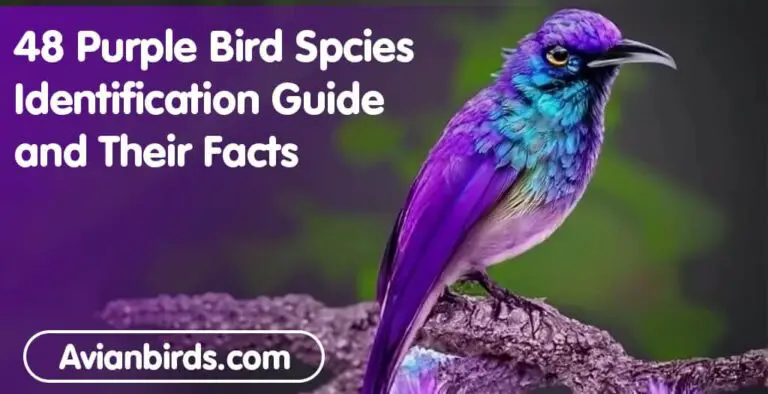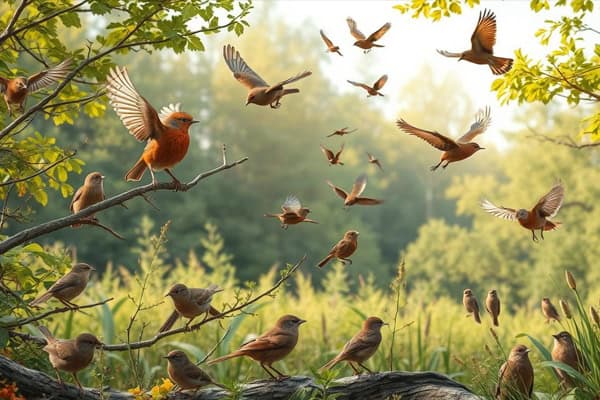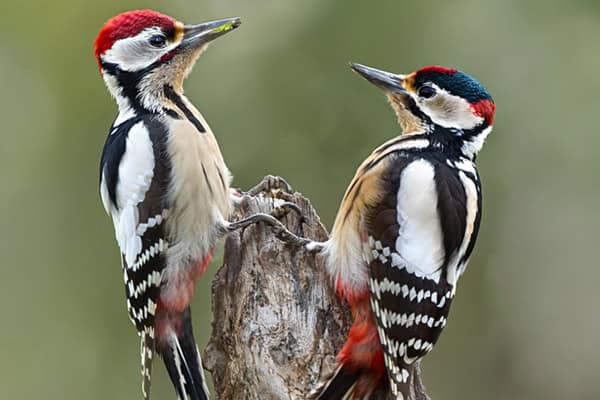Woodpeckers in Missouri (7 Species to Know)
Have you ever wondered about the woodpeckers in Missouri? The state is home to over 400 bird species, making it a great place for these fascinating birds. Woodpeckers are known for their unique way of finding food and making homes by pecking on trees.
8 Woodpecker Species Found in Missouri Today
Missouri is home to eight different woodpecker species. These include the famous Red-bellied Woodpecker and the big Pileated Woodpecker. Each one adds to the state’s rich bird life.
- Red-bellied Woodpecker
- Red-headed Woodpecker
- Pileated Woodpecker
- Downy Woodpecker
- Hairy Woodpecker
- Northern Flicker
- Yellow-bellied Sapsucker
Two woodpeckers used to live in Missouri but are now gone. But eight species are still around today. Each has its own look, behavior, and where it likes to live and eat.
The Downy Woodpecker is small and easy to spot with its black and white feathers. The Hairy Woodpecker is a bit bigger and looks similar. The Northern Flicker stands out with its brown and black feathers and likes to forage on the ground.
The Pileated Woodpecker is the biggest woodpecker in North America. It’s known for its big size and red crest. The Red-headed Woodpecker has a bright red head but its numbers have dropped a lot because of habitat loss.
Woodpeckers in Missouri are important for the health of the forests. They help control pests by eating insects and larvae. By protecting these birds, we can keep Missouri’s woodpecker diversity alive for the future.
1. Red-bellied Woodpecker
The Red-bellied Woodpecker (Melanerpes carolinus) is a common sight in Missouri. It has a medium size and a unique look with a buffy-white belly. Sometimes, this belly shows a faint red wash. The male has a bright red crown and nape. The female has red only on the nape.

Identification and Sounds
This woodpecker is known for its loud, high-pitched “churr” or “kwirr” sounds. These sounds fill the woodlands and forests where it lives.
Habitat and Nesting
The Red-bellied Woodpecker lives in the eastern United States. It thrives in woodlands, forests, and even suburban areas with many deciduous trees. They often use the same nesting spots every year. These spots can be in dead or live trees.
Diet and Feeding Habits
The Red-bellied Woodpecker eats a mix of insects, spiders, and other small animals. They also eat plant stuff like pine cones, nuts, acorns, seeds, and fruits. With their sharp beaks, they find food both in the air and on the ground. This way, they get enough animal and plant food.
2. Red-headed Woodpecker
The red-headed woodpecker stands out with its bright red head. This covers the entire crown and goes down to the upper back. The rest of its body is black and white, with a white belly and big white patches on its wings. These patches show when they fly.
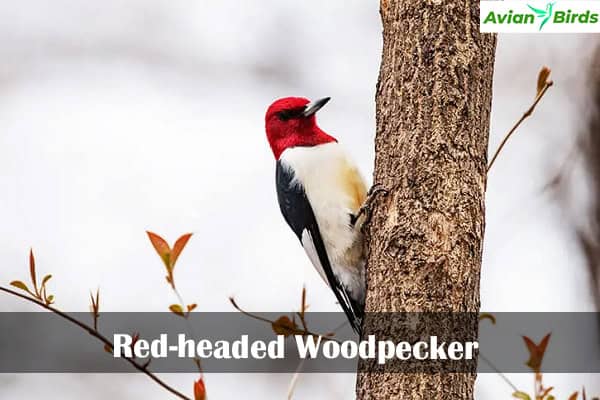
This look has led to nicknames like the “flag bird” or “patriotic bird”.
This bird makes loud, harsh calls. Its main sound is a “tchur” that warns others and marks its territory. It also makes clicks, rattles, and chattering sounds.
Nesting Behavior
Red-headed woodpeckers often use the same nest year after year. They make their nests in dead trees, or sometimes in buildings or poles. The nest is deep in the tree, 8-24 inches down, offering safety for their young.
These woodpeckers live in open forests, prairies, and areas with trees near water. They’re not as common in Central Missouri as some other woodpeckers. But, they can be seen in places like Pershing State Park near Meadville, where they’re more numerous.
3. Pileated Woodpecker
The Pileated Woodpecker (Dryocopus pileatus) is the biggest woodpecker in North America. It’s known for its red crest, black and white feathers, and size. It can be as big as a crow, with a wingspan of about 29 inches. These birds live in Missouri, enjoying the mixed forests and areas with lots of dead trees.
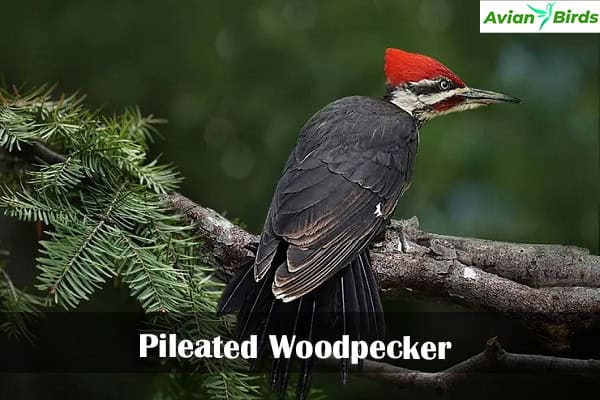
Habitat and Nesting Sites
Pileated woodpeckers need forests with old, dead trees for their homes. They make big, rectangular nests in these trees, often in dead or decaying ones. They don’t use the same nest every year, making new ones each season.
Diet and Feeding Preferences
The pileated woodpecker eats a lot of carpenter ants and other insects. It also eats nuts, fruits, and small animals. They use their strong beaks to make big holes in trees while searching for food, leaving behind marks as they go.
Pileated woodpeckers are amazing birds, showing how diverse Missouri’s forests are. By learning about where they live, nest, and eat, we can help protect them for the future.
4. Downy Woodpecker
The Downy Woodpeckers (Dryobates pubescens) is a small bird in Missouri with a short beak for a woodpecker. It’s easy to spot because of its black and white stripes on the head. The male has a red nape, and both sexes have white underparts with a black upper body and white-spotted wings. Its call sounds like a series of shrill notes that turn lower towards the end, often called a whinny.

Identification and Calls
This bird is only 6 inches long, making it the smallest woodpecker in Missouri. It’s very active, darting between trees to find food. It makes a sharp “peek” call and a rhythmic drumming sound to claim its territory and find a mate.
Habitat and Nesting Habits
The Downy Woodpecker lives in deciduous woodlands and other wooded areas, even in suburban places, parks, and orchards. It nests in dead trees or parts of live trees with fungus, making it easier to dig a hole. The female lays four to five eggs, which she incubates for 12 days. The young birds leave the nest in 20 to 25 days.
This bird is loved for its unique look, sounds, and ability to live in different places. It’s a common and charming bird in Missouri’s bird world.
Other Woodpecker Species in Missouri
Missouri is home to many woodpecker species, including the Hairy Woodpecker, Northern Flicker, and Yellow-bellied Sapsucker. These birds are as interesting as the Red-bellied and Pileated Woodpeckers.
5. Hairy Woodpecker
- Scientific name – Leuconotopicus villosus
- Lifespan – 15 years (maximum recorded)
- Size – (22 cm)
- Weight – (67 g)
- Wingspan – (37 cm)
The Hairy Woodpecker looks a bit like the Downy Woodpecker but is bigger. It has a longer bill and a larger head. Known for its black-and-white look, it often searches far from its home in Missouri’s forests.

6. Northern Flicker
- Scientific name – Colaptes auratus
- Lifespan – 9 years (maximum recorded)
- Size – (32 cm)
- Weight – (126.5 g)
- Wingspan – (48 cm)
The Northern Flicker is a big woodpecker with bright yellow underwings. It’s known for its flicking behavior. You can see it on the ground, eating ants and other bugs.

7. Yellow-bellied Sapsucker
- Scientific name – Sphyrapicus varius
- Lifespan – 7 years (maximum recorded)
- Size – (20 cm)
- Weight – (50.3 g)
- Wingspan – (37 cm)
The Yellow-bellied Sapsucker drills holes in trees to get sap. This makes it a special bird in Missouri’s woodpecker group.

These birds, along with the Red-bellied and Downy Woodpeckers, make Missouri’s woodpeckers diverse. Each has its own way of living and behaving, making them great for birdwatchers and nature lovers.
Check Our Previous Articles:
Wrapping Up…
Missouri is home to a wide variety of woodpeckers species, with eight types found in the state. These birds have special features like zygodactyl feet and stiff tail feathers. They also have long tongues and bones that protect them from drumming injuries.
Woodpeckers are crucial to Missouri’s ecosystems. They help control insect populations and make homes for other animals. By learning about these birds, we can help protect them and the roles they play in nature.
The Red-headed Woodpecker has seen a big drop in numbers over the years. This decline is due to more predators, warmer winters, and changes in forests. We need to understand these issues to help these birds.
When you visit Missouri’s nature, look out for its woodpeckers. Their unique traits show the amazing variety of life in Missouri. By supporting these birds, we can keep Missouri’s ecosystems healthy.





